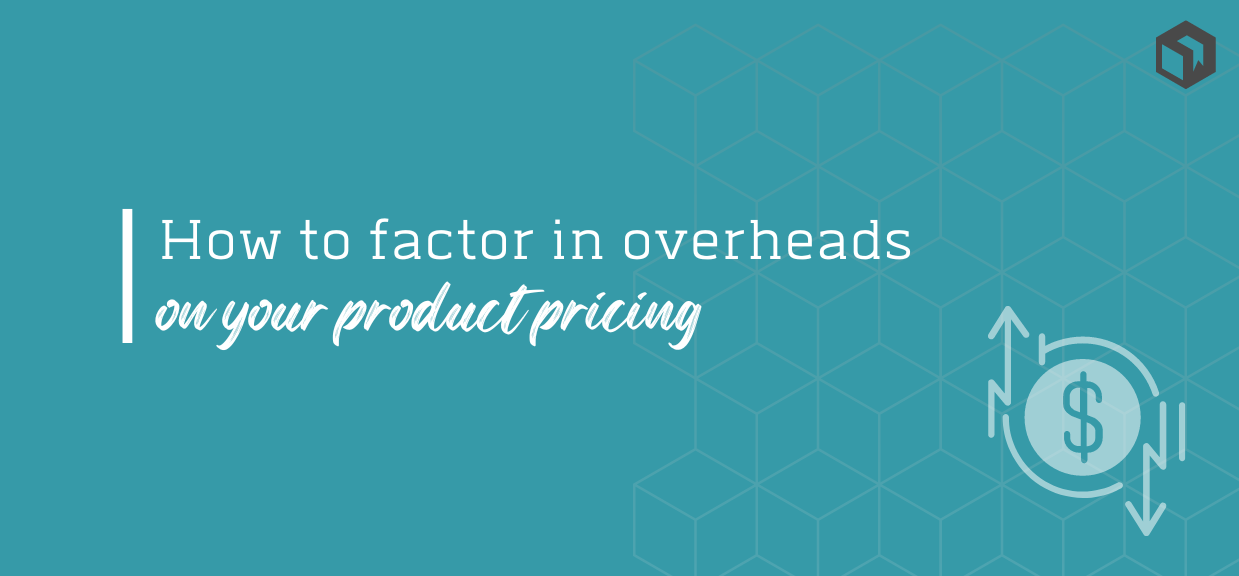How to factor in overheads in your product pricing
It's important to factor in your overhead costs to your pricing so that you can be sure you are covering all of your costs and maximising your profit margins.

To get your product pricing accurate and reliable, it’s important to figure out how to factor in overheads into your product pricing so that you can be sure you are covering all of your costs.
This article will firstly explain what an overhead is, and then guide you through how to factor these hidden costs into your pricing to ensure that you are maximizing your profit margins.
☞ Take the guesswork out of pricing your products. Craftybase is inventory software that can calculate your pricing, including overheads, all in real-time.
Start your free 14-day trial today →
What is an Overhead Cost?

Let’s start by talking about exactly what an overhead cost is. Overheads, for small manufacturing businesses, are essential any costs that are not directly related to the creation of your products.
They are also known as “indirect costs” as they are indirectly related to your manufacturing and production activities.
If you don’t factor in your overheads, then there’s a good chance that you are not making enough profit from each sale to cover all of your costs. This can quickly lead to your business becoming unprofitable (and you may not realize it until it is too late!)
Some common examples of overheads are:
- Rent or mortgage payments
- Business rates
- Water and electricity bills
- Internet and phone costs
- Insurance
- Office Equipment
- Marketing and advertising spend
- Accounting and bookkeeping fees
- Software subscriptions
As you can see, there are a lot of potential overhead costs that can quickly add up! And, as a small business owner, it’s important to try and factor as many of these in as possible to your product pricing to ensure you are calculating accurate margins.
Fixed vs variable costs
Overheads can also be split into two different categories: fixed costs and variable costs.
Fixed overhead costs are costs that stay the same every month, regardless of how much you sell. A good example of this would be your monthly rent payments.
Variable overhead costs are costs that change each month, depending on how much you sell. A good example of variable costs would be how much you spend on packaging materials - the more you sell, the more packaging you’ll need to buy!
It’s important to try and identify both types of costs when you are calculating your overheads, as they will both need to be factored into your pricing in different ways.
How can I factor in overheads into my product pricing?

As overheads can’t be tallied per product easily, they are almost impossible to factor into your pricing with the same accuracy as your material costs - this is why many sellers neglect to include these costs in their calculations.
There are, however, some ways that you can estimate your overheads with enough confidence to allow you to include them in your margins.
The first step is to ensure you know which of your costs are your direct costs: the costs directly required to bring your product from raw materials through to finished sellable product.
Creating a bill of materials (aka a BoM) for your product is a great first step as you’ll be able to clearly identify which items are directly used to create your products and which are not.
From the list of costs that cannot be attributed to the creation of your products (aka your overhead costs), you’ll now have the information you need to start calculating an overhead amount you can factor into your pricing.
Check out our free BOM template for Excel and Numbers here →
How to calculate your overhead costs
Now that we have a better idea on your indirect costs, to factor in your overheads, you’ll want to instead aim for a good “guestimate” of your costs. There are a couple of common approaches that you can use, so it’s just a case of finding the one that works best for your product range.
From here, you’ll then want to create a formula that tries to fairly incorporate a proportion of these costs into each of your products.
So, from your list of indirect expenses you have created above, you’ll now want to tally all indirect (i.e. non production) costs that you incurred in the last financial year to give you your total annual overhead cost.
Once you have this figure, you can now decide how to best spread this cost out over your products.
Option A - Historical overheads
If your sales are fairly consistent from year to year and you have historical data available, you could try to calculate a suitable overhead amount using last year’s sales figures. You can use the following formula to do this:
Last Year’s Overhead ÷ Last Year’s Sales = Last Year’s Overhead per Sale
If you sold 2500 items last year and had an overhead of $10,000 then your overhead per product would have been:
$10,000 ÷ 2500 = $4.
If you are anticipating roughly the same amount of overhead expenditure and sales for this year, then it may be reasonable to ensure that an overhead of $4 is included in each product you sell.
If you are experiencing growth in your business, you might like to modify the above formula and use your last year’s sales to estimate your likely sales for this year.
Total Projected Overhead ÷ Total Projected Sales = Overhead per Sale
Say you are growing 10% a year, then if you sold 2500 items last year then you might like to increase this in your calculations to 2750. Hopefully, your overheads are not increasing at the same rate as your sales, so let’s say that they only rise by 5% to an estimate of $10,500 for the coming year.
The calculation for your overheads, including anticipated growth would therefore be:
$10,500 ÷ 2750 = $3.81
You can do the calculations above on either your yearly or monthly overhead costs.
Option B - Percentage-based overheads
If your product range substantially varies by price, then using a fixed cost approach to your overhead costs may not be the best approach for you as you’ll be increasing your base cost for all products equally. Although it may not be an issue to increase a $2400 product by $4 to ensure overheads are included, this will have a much bigger impact on your $8 items. To get around this, you can instead calculate your overheads as a percentage of the base cost to produce each product.
This method is less accurate, as you’ll be deciding on a percentage to apply to each product based on what feels right. Running these percentages against your previous year’s sales to see what total overhead it generates can be a good idea to see if you are on the right track.
To do this, you’ll need a list of all sales along with the material cost of each item sold (if you are using Craftybase, you can create this view by exporting your order line items for 1st Jan - 31 Dec of the previous year). Open this file in your spreadsheet program and add an extra column to this using a formula to calculate your estimated overhead from the percentage you have chosen. As an example:
| Date | Item Sold | Cost to Produce | Overhead Percentage | Overhead |
|---|---|---|---|---|
| 1 Jan | Apple Skirt | $16.56 | 10% | $1.656 |
From here, you’ll want to tally the Overhead column to see how this compares to your total overhead costs from the previous year. If it isn’t close enough, adjust the percentage calculation and repeat if necessary.
Using your overhead calculations to create more accurate pricing
Once you have a percentage or fixed amount in mind, you can now use total estimated overhead cost formula above to recalculate your product prices to ensure that you are maintaining your desired profit margins. Our blog post here will show you how to do this in more detail: How to calculate pricing markups for your products →
For either approach, you might like to make this more granular and group together your products first before running your overhead calculations - this can be useful if you’d like to apply more of an overhead markup to one group of products over another. Another option again is to apply a lower overall business overhead to all products and then customized overhead markups on your individual products.
Using software to factor in overheads to your product prices

As mentioned earlier, using pricing software like Craftybase can automate much of the process of calculating your overheads and applying them to your pricing. Best of all, as Craftybase also tracks your raw material stock and costings you’ll have up to the minute pricing and margins guidance. Craftybase also features:
-
Full financial reporting on your business performance
-
Inventory management to streamline your stocktaking and reordering
-
Automatic order tracking integrations with leading marketplaces
-
And much more…
Why not try out Craftybase for free today and see how we can help.
Conclusion
Whatever path you do choose, the important thing to keep in mind is that you are factoring in some consideration to your business overhead costs. The more overhead costs you try to factor into your pricing, the better your margins will become and the healthier your handmade business will be!
Read next: How to calculate your internal manufacturing labor costs →
